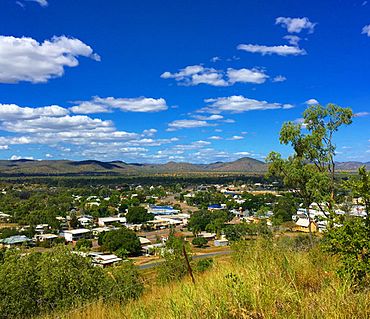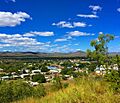Collinsville, Queensland facts for kids
Quick facts for kids CollinsvilleQueensland |
|||||||||||||||
|---|---|---|---|---|---|---|---|---|---|---|---|---|---|---|---|

Collinsville, May 2018
|
|||||||||||||||
| Population | 1,496 (2021 census) | ||||||||||||||
| • Density | 53.62/km2 (138.9/sq mi) | ||||||||||||||
| Postcode(s) | 4804 | ||||||||||||||
| Elevation | 187 m (614 ft) | ||||||||||||||
| Area | 27.9 km2 (10.8 sq mi) | ||||||||||||||
| Time zone | AEST (UTC+10:00) | ||||||||||||||
| Location | |||||||||||||||
| LGA(s) | Whitsunday Region | ||||||||||||||
| State electorate(s) | Burdekin | ||||||||||||||
| Federal Division(s) | Capricornia | ||||||||||||||
|
|||||||||||||||
|
|||||||||||||||
Collinsville is a small town and area in the Whitsunday Region of Queensland, Australia. It's a rural place, meaning it's mostly countryside. In 2021, about 1,496 people lived in Collinsville.
Contents
- Where is Collinsville Located?
- A Brief History of Collinsville
- What is the Population of Collinsville?
- Places of Historical Interest
- What is the Economy of Collinsville Like?
- What Facilities and Services Does Collinsville Have?
- Education in Collinsville
- What Can You See and Do in Collinsville?
- Images for kids
Where is Collinsville Located?
Collinsville is in a part of Central Queensland called the Bowen Basin. This area is known for having lots of coal. The town is about 1,245 kilometres (774 miles) north of Brisbane, which is the capital city of Queensland. It's also about 87 kilometres (54 miles) south-west of the coastal town of Bowen.
A main road called the Bowen Developmental Road goes through Collinsville. This road connects the town to Bowen in the north-east. A railway line, part of the Newlands railway system, also runs through Collinsville. This railway is mainly used to transport coal from the local mines.
What is the Weather Like in Collinsville?
Collinsville has a warm climate. The hottest month is usually December, with average high temperatures around 34.6 degrees Celsius (94.3 degrees Fahrenheit). The coolest month is July, with average high temperatures around 25.6 degrees Celsius (78.1 degrees Fahrenheit).
The town gets most of its rain during the summer months, from January to March. The driest months are usually July, August, and September.
| Climate data for Collinsville, Queensland (1991–2020 normals, extremes 1955–present) | |||||||||||||
|---|---|---|---|---|---|---|---|---|---|---|---|---|---|
| Month | Jan | Feb | Mar | Apr | May | Jun | Jul | Aug | Sep | Oct | Nov | Dec | Year |
| Record high °C (°F) | 44.0 (111.2) |
43.3 (109.9) |
40.7 (105.3) |
36.9 (98.4) |
34.7 (94.5) |
32.8 (91.0) |
32.0 (89.6) |
34.2 (93.6) |
36.6 (97.9) |
39.9 (103.8) |
41.9 (107.4) |
42.2 (108.0) |
44.0 (111.2) |
| Mean daily maximum °C (°F) | 33.8 (92.8) |
33.2 (91.8) |
32.5 (90.5) |
30.7 (87.3) |
27.9 (82.2) |
25.6 (78.1) |
25.6 (78.1) |
27.2 (81.0) |
30.3 (86.5) |
32.6 (90.7) |
33.9 (93.0) |
34.6 (94.3) |
30.7 (87.3) |
| Daily mean °C (°F) | 28.1 (82.6) |
27.7 (81.9) |
26.4 (79.5) |
24.0 (75.2) |
21.0 (69.8) |
18.4 (65.1) |
17.7 (63.9) |
19.0 (66.2) |
22.3 (72.1) |
25.1 (77.2) |
26.9 (80.4) |
28.2 (82.8) |
23.7 (74.7) |
| Mean daily minimum °C (°F) | 22.3 (72.1) |
22.3 (72.1) |
20.3 (68.5) |
17.4 (63.3) |
14.0 (57.2) |
11.2 (52.2) |
9.7 (49.5) |
10.9 (51.6) |
14.2 (57.6) |
17.7 (63.9) |
20.0 (68.0) |
21.8 (71.2) |
16.8 (62.2) |
| Record low °C (°F) | 15.0 (59.0) |
15.6 (60.1) |
10.2 (50.4) |
6.6 (43.9) |
1.7 (35.1) |
−1.1 (30.0) |
−1.0 (30.2) |
−1.1 (30.0) |
2.2 (36.0) |
7.3 (45.1) |
12.8 (55.0) |
14.3 (57.7) |
−1.1 (30.0) |
| Average precipitation mm (inches) | 137.7 (5.42) |
163.1 (6.42) |
72.6 (2.86) |
32.4 (1.28) |
27.2 (1.07) |
25.2 (0.99) |
13.6 (0.54) |
20.2 (0.80) |
13.2 (0.52) |
21.2 (0.83) |
42.5 (1.67) |
96.0 (3.78) |
664.9 (26.18) |
| Average precipitation days (≥ 1.0 mm) | 8.7 | 10.5 | 5.9 | 3.4 | 2.6 | 2.7 | 1.1 | 1.5 | 1.4 | 2.3 | 3.7 | 6.5 | 50.3 |
| Average dew point °C (°F) | 20.4 (68.7) |
21.0 (69.8) |
19.5 (67.1) |
17.0 (62.6) |
14.1 (57.4) |
11.5 (52.7) |
9.9 (49.8) |
10.3 (50.5) |
12.9 (55.2) |
15.2 (59.4) |
17.1 (62.8) |
19.0 (66.2) |
15.7 (60.3) |
| Source 1: National Oceanic and Atmospheric Administration | |||||||||||||
| Source 2: Bureau of Meteorology | |||||||||||||
A Brief History of Collinsville
The land around Collinsville has been home to the Biri Aboriginal people for a very long time. Their language is part of a larger group of Aboriginal languages in Central and North Queensland.
European settlers first came to this area in 1861, mainly to set up large farms for raising cattle. Some of these cattle stations are still working today.
Coal was found here in 1866. But it wasn't until 1912 that big mining operations started. The town was first called Moongunya, which is an Aboriginal word meaning "place of coal."
On September 20, 1921, the town was officially renamed Collinsville. It was named after Charles Collins, who was a local politician. He represented the area in the Queensland Parliament from 1915 to 1936.
Important Dates in Collinsville's History
- 1921: Collinsville State School opened, providing education for local children.
- 1923: The Collinsville Post Office opened, allowing people to send and receive mail.
- 1927: Our Lady of Lourdes Catholic Church was officially opened. Many people, including a brass band, came from Bowen on a special train for the event.
- 1936: St John Bosco Catholic School was started by the Sisters of Mercy. It was named after Saint John Bosco, a priest who cared deeply about helping children through education.
- 1948: The Collinsville Methodist Church officially opened. Later, in 1977, it became the Collinsville Uniting Church when different churches joined together.
- 1954: A sad event happened at the Collinsville coal mine. Seven miners lost their lives when a large amount of earth collapsed in the mine. This was a very difficult time for the community.
- 1986: Collinsville State High School opened, giving older students a place to continue their education in town.
What is the Population of Collinsville?
The number of people living in Collinsville has changed over the years:
- In 2011, there were 1,501 people.
- In 2016, the population went down to 1,248 people.
- By 2021, it went back up to 1,496 people.
Places of Historical Interest
Collinsville has a few places that are important to its history and are protected as "heritage-listed" sites:
- Collinsville Cemetery: This is the local cemetery, located on Collinsville-Scottville Road.
- Bowen River Hotel: This historic hotel is on Strathbowen-Leichhardt Range Road.
What is the Economy of Collinsville Like?
The main industry in Collinsville is coal mining. The town is home to several coal mines, including the Collinsville coal mine and the Sonoma Mine. These mines provide many jobs for people in Collinsville and the surrounding areas.
The town is also looking to grow in other ways. There are plans for more mining projects. Also, green energy, like solar power, is becoming important. It is expected to create new jobs in Collinsville. There is also hope for a new road that would connect Collinsville to Proserpine. This would make travel faster and open up new chances for development and trade.
What Facilities and Services Does Collinsville Have?
Collinsville has many useful facilities for its residents:
- A district hospital for medical care.
- A pharmacy, newsagent, and bakery.
- Two fuel stations and two medium-sized grocery stores.
- Shops where you can buy clothing and a hardware store.
Community and Sporting Amenities
The Whitsunday Regional Council runs the Collinsville Library, which opened in 1982. It's a great place to find books and learn.
The Collinsville branch of the Queensland Country Women's Association (QCWA) also meets in town. The QCWA is a group that supports women and communities.
There are four churches in Collinsville:
- Catholic (Our Lady of Lourdes Catholic Church at 28 Stanley Street)
- Anglican
- Uniting (Collinsville Uniting Church at 33 Sonoma Street)
- Assembly of God
For sports and recreation, Collinsville has:
- A golf course
- Rugby league grounds
- Tennis courts
- A public swimming pool
- Squash courts
- Lawn bowls
Education in Collinsville
Collinsville has schools for all ages:
- Collinsville State School: A primary school. In 2014, it had 42 students and 4 teachers.
- St John Bosco's Catholic Primary School: Another primary school. In 2016, it had 50 students.
- Collinsville State High School: For older students. In 2014, it had 77 students and 12 teachers.
What Can You See and Do in Collinsville?
Collinsville has a special park for recreational vehicles (RVs) and campervans. You can stay there for free for up to 72 hours, which is great for people traveling through the area.
Images for kids



